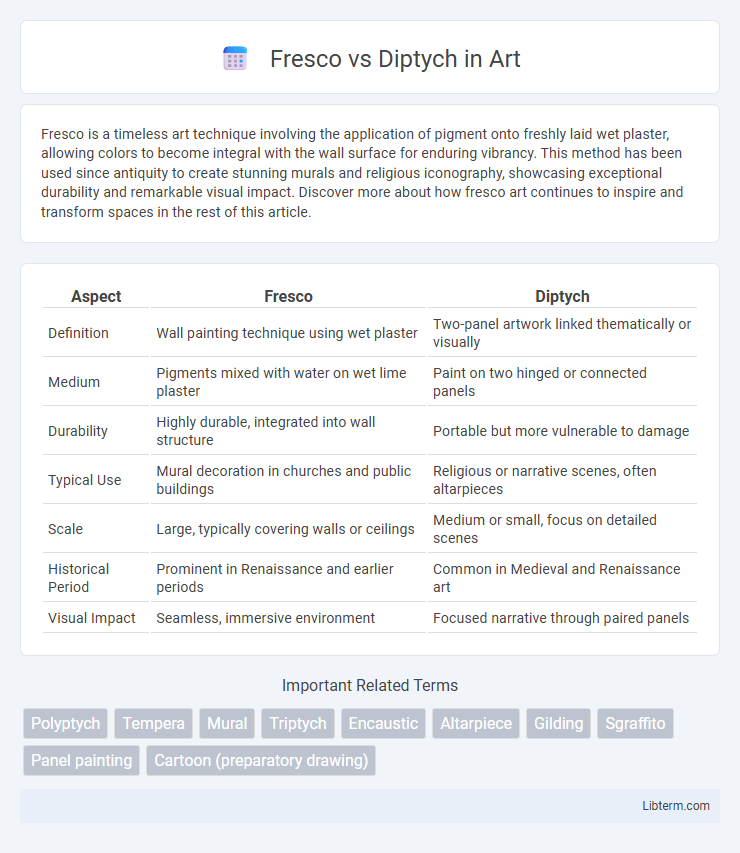Fresco is a timeless art technique involving the application of pigment onto freshly laid wet plaster, allowing colors to become integral with the wall surface for enduring vibrancy. This method has been used since antiquity to create stunning murals and religious iconography, showcasing exceptional durability and remarkable visual impact. Discover more about how fresco art continues to inspire and transform spaces in the rest of this article.
Table of Comparison
| Aspect | Fresco | Diptych |
|---|---|---|
| Definition | Wall painting technique using wet plaster | Two-panel artwork linked thematically or visually |
| Medium | Pigments mixed with water on wet lime plaster | Paint on two hinged or connected panels |
| Durability | Highly durable, integrated into wall structure | Portable but more vulnerable to damage |
| Typical Use | Mural decoration in churches and public buildings | Religious or narrative scenes, often altarpieces |
| Scale | Large, typically covering walls or ceilings | Medium or small, focus on detailed scenes |
| Historical Period | Prominent in Renaissance and earlier periods | Common in Medieval and Renaissance art |
| Visual Impact | Seamless, immersive environment | Focused narrative through paired panels |
Introduction to Fresco and Diptych
Fresco is an ancient mural painting technique where pigments are applied onto freshly laid lime plaster, resulting in vibrant, long-lasting artwork integrated with the wall surface. Diptych refers to a two-paneled artwork, often hinged, used in religious or decorative contexts to present complementary images or narratives side by side. Both forms represent distinctive methods of visual storytelling, with fresco emphasizing large-scale wall painting and diptychs focusing on portable, dual-panel compositions.
Historical Origins and Evolution
Fresco painting originated in ancient civilizations such as the Minoans and Greeks, flourishing during the Italian Renaissance with artists like Michelangelo innovating the technique on wet plaster walls. The diptych, rooted in Late Antiquity and Byzantine art, evolved as a portable two-panel artwork often used for religious purposes and personal devotion. Over centuries, frescoes remained integral to large-scale mural art, while diptychs expanded in thematic diversity and size, reflecting shifts in social and artistic contexts.
Techniques and Materials Used
Fresco involves applying water-based pigments directly onto freshly laid lime plaster, allowing the paint to chemically bond with the wall for durability and vibrant color retention. Diptychs consist of two hinged panels often painted with tempera or oil on wood, enabling detailed imagery and portability for altarpieces or devotional purposes. Fresco demands quick work before the plaster dries, while diptychs offer longer working times and the ability to create intricate, layered compositions.
Artistic Purposes and Symbolism
Fresco painting, often found on walls and ceilings, serves artistic purposes by creating enduring, immersive visual narratives that symbolize religious, mythological, and historical themes, emphasizing permanence and sacredness. Diptychs, typically consisting of two hinged panels, function as portable devotional objects or commemorative artworks, symbolizing duality, contrast, or dialogue between paired images to convey spiritual or emotional connections. Both mediums utilize symbolism to enhance viewer engagement, with frescoes highlighting collective cultural identity and diptychs emphasizing personal reflection or intimate storytelling.
Fresco: Key Characteristics
Fresco painting involves applying pigment onto freshly laid wet plaster, allowing the colors to chemically bond with the wall surface for exceptional durability. This technique, prominent in Renaissance art, enables vibrant, long-lasting hues that resist fading over centuries. Key characteristics include its integration with architectural surfaces, requiring swift execution before the plaster dries and yielding a matte finish that enhances depth and texture.
Diptych: Key Characteristics
Diptychs consist of two hinged panels often used in religious or commemorative art, allowing for portable and versatile displays. Key characteristics include their symmetrical format, detailed iconography on each panel, and use of wood or ivory as common materials. The hinged construction facilitates folding for protection and ease of transport, distinguishing diptychs from permanent wall-bound frescoes.
Notable Examples in Art History
Fresco technique is exemplified by Michelangelo's Sistine Chapel ceiling, showcasing vibrant pigments applied on wet plaster, creating durable and monumental imagery. Diptychs, often found in Byzantine and Medieval art, include the Wilton Diptych, a richly detailed devotional panel displaying two hinged sections with intricate religious iconography. These distinct mediums highlight fresco's integration with architectural surfaces and diptych's portability, serving different artistic and functional purposes throughout art history.
Preservation and Conservation Challenges
Fresco murals, created by applying pigment onto wet plaster, face significant preservation challenges due to their vulnerability to moisture, salt efflorescence, and structural wall damage, often requiring careful environmental control and consolidation techniques. Diptychs, typically composed of two hinged painted panels on wood or canvas, encounter conservation issues such as panel warping, paint layer cracking, and joint deterioration, necessitating climate stabilization and meticulous physical support. Both art forms demand specialized conservation strategies to address their distinct material compositions and environmental susceptibilities, ensuring long-term stability and visual integrity.
Fresco vs Diptych: Comparative Analysis
Fresco and diptych are distinct artistic mediums with unique techniques and historical contexts. Fresco, a mural painting technique involving pigment applied to wet plaster, offers durability and vibrant color longevity ideal for large-scale wall art, while diptychs consist of two hinged wooden panels often used for portable religious or devotional imagery. The comparative analysis reveals frescos' integration into architectural spaces contrasts with diptychs' intimate, portable format, emphasizing different functions and viewer interactions in art history.
Impact on Contemporary Art
Fresco technique, rooted in ancient traditions, profoundly shapes contemporary muralism by promoting durability and vibrant color integration within architectural spaces. Diptych art, characterized by two-paneled compositions, influences modern storytelling through its dynamic narrative and visual interplay that invites viewers to engage with dual perspectives. The juxtaposition of these mediums enhances contemporary art's exploration of space, time, and cultural dialogue, bridging historical methods with innovative expression.
Fresco Infographic

 libterm.com
libterm.com